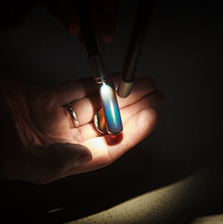
Researchers at ITMO University developed a new approach for obtaining non-toxic magnetic photonic crystals, expanding their applications from mainly photonics to biomedicine. Nanospheres made with the new method may be used for designing drugs to fight thrombosis and cancer. The results of the research were published in Scientific reports.
Magnetic photonic crystal (MPC) is basically a complex of nanoparticles that can selectively change its reflectance spectra under the influence of an applied magnetic field. Such crystals can be used in photonics for making optical fibers, filters and other applications. While application of such systems holds a high potential, there are some problems concerning the synthesis of MPC. This procedure requires sophisticated equipment, high temperature and pressure as well as highly toxic chemicals.
Scientists from ITMO University along with their colleagues from Saint Petersburg Electrotechnical University and N.N. Blokhin Russian Cancer Research Center suggested an inexpensive and simple method which enables MPC production in mild conditions and without toxic chemicals. The method is based on the controlled destabilization process of magnetic nanoparticles solution resulting in formation of larger nanocrystals. The key feature of the process is that the reagents used for this purposes are known to be non-toxic and are approved by FDA (Food and Drug Administration) and EMA (European Medical Agency) for parenteral administration. The resulting nanocrystals have similar sizes, excellent stability and are able to form periodic structures under the influence of magnetic fields. Such features make it possible to regulate the wavelength of light reflected by nanocrystals, which may be useful for constructing various sensory, communication and navigation systems.
Owing to their biocompatibility, such nanospheres can also be used in biomedicine for targeted drug delivery.
“Unlike its alternatives, our method is suitable for diverse fields rather than just for optics and photonics. Due to mild synthesis conditions we are able to modify our technique in order to incorporate drugs in the structure of nanospheres,” explains Andrey Drozdov, researcher at the SCAMT Laboratory in ITMO University. “We are currently working on drugs for thrombosis and breast cancer treatment. Since we avoid using toxic chemicals, such drugs are safe to inject into the body. As soon as they reach the required tissue we can apply a magnetic field to separate MNS and release the medicine with precision.”
Another advantage of the suggested method is flexibility. Controllable destabilization enables to obtain nanospheres from various materials or their mixtures.
“In this research we have used magnetite: iron oxide with a strong response to magnetic field. By adding other metal oxides, however, we could achieve hybrid nanospheres with features that were previously inconceivable,” says Andrey Drozdov.
Reference: “The controllable destabilization route for synthesis of low cytotoxic magnetic nanospheres with photonic response”
Y. I. Andreeva, A. S. Drozdov et al. Scientific reports Sep. 12, 2017
(author Anastasia Komarova)